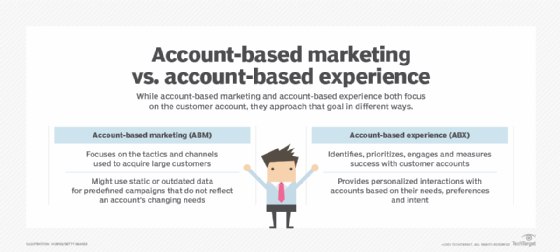account-based experience (ABX)
What is account-based experience (ABX)?
Account-based experience (ABX) is a business-to-business (B2B) strategy in which the sales, marketing and customer success departments work together to provide accounts with a unified, personalized experience throughout the buyer journey.
ABX enhances an organization's account-based marketing (ABM) efforts by using data intelligence to reach out to accounts during their journey. This provides buyers with a better experience overall and helps make your brand more trusted. The common thread between ABM and ABX is a focus on the customer account.
How is ABX different from ABM?
While ABX and ABM strategies both target high-quality customer B2B accounts, they approach that goal in different ways.
Account-based marketing focuses more on the tactics and channels used to acquire large customers, using an outbound sales approach that might use static or outdated data. ABM might also execute predefined campaigns that do not reflect the changing needs of accounts.
Account-based experience is a more data-driven approach that identifies, prioritizes, engages and measures success with customer accounts. It requires strong alignment among sales, marketing and customer service teams. ABX strives to provide personalized and engaging interactions with each account based on their needs, preferences and intent. The goal is to keep customers loyal and satisfied during their entire journey and to improve pipeline quality, conversion rates and revenue growth.

ABX importance: What factors are driving the need for ABX?
The following three factors are driving the need for ABX:
- The changing expectations and behaviors of B2B buyers. Buyers today are more informed, empowered and demanding than ever before. They expect personalized, relevant and respectful interactions throughout their journey, not just during the marketing or sales phases. The goal of an ABX strategy is to nurture the account relationship at all stages of the buying journey.
- The increasing complexity and competition in the B2B market. B2B companies face more challenges and opportunities, such as new technologies, regulations, channels and competitors. To stand out and win in this environment, they must deliver a consistent and differentiated customer experience that builds trust and loyalty with their accounts. ABX strives to maintain consistent messaging from the sales, marketing and customer success teams and to provide accounts with the information they need to make an informed decision regarding their particular situation and pain points.
- The growing importance of customer retention and expansion. B2B companies realize that acquiring new customers is insufficient to sustain growth and profitability. They must also retain and expand their existing customers by providing value-added services, support and solutions. An account-based experience helps ensure a seamless and satisfying experience throughout the customer lifecycle.
Core concepts of an ABX strategy
The following are the core concepts of an account-based experience strategy.
1. Build awareness
Build brand awareness with qualified accounts without the use of aggressive sales tactics. Provide educational content and other material that builds trust in your brand.
2. Use personalized interactions to nurture accounts
If the account is in the buying decision phase of their journey, reach out through personalized emails, direct mail, trials and other offers to garner more interest.
3. Team up to close customer deals
Use your cross-functional teams to provide the account with reports from analyst firms, third-party reviews and other content that helps them compare your offerings with other vendors in a positive manner. This information should help them make their final purchase decision.
4. Show your appreciation
Once the sale has been made, continue to interact with the account. Keep them up to date regarding new versions, updated ways to use the product or other products that might be helpful to them.
Best practices for successfully implementing ABX
The following are some best practices for implementing a successful ABX strategy:
- Know your audience. Research the content your potential buyers look at, as well as the ways -- videos, blogs, podcasts, social media -- they access this information.
- Use accurate data to drive account interactions. Knowing where the account is in their buying journey lets you provide the correct personalized approach at each stage.
- Create the right content. All content should answer the questions, challenges and needs of the account at each stage of the buying journey.
- Be consistent. Ensure all marketing and sales efforts deliver the same message and provide outstanding customer interaction.
- Use key performance indicators. Measure the success of your efforts to understand what is working or not working at each stage of the customer experience journey. Then make changes as needed to improve future account interactions.
Editor's note: TechTarget offers ABM and project intelligence data, tools and services.







